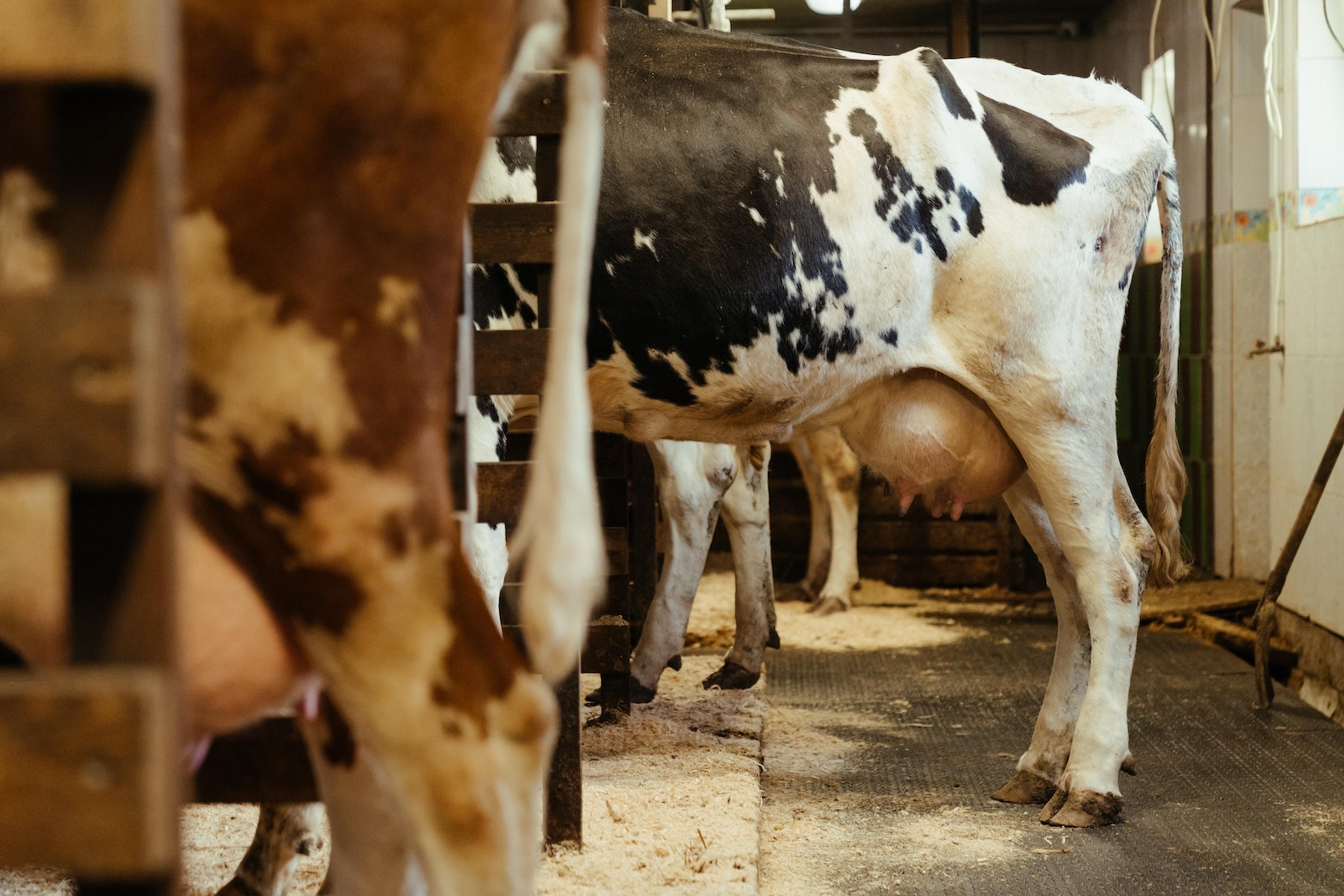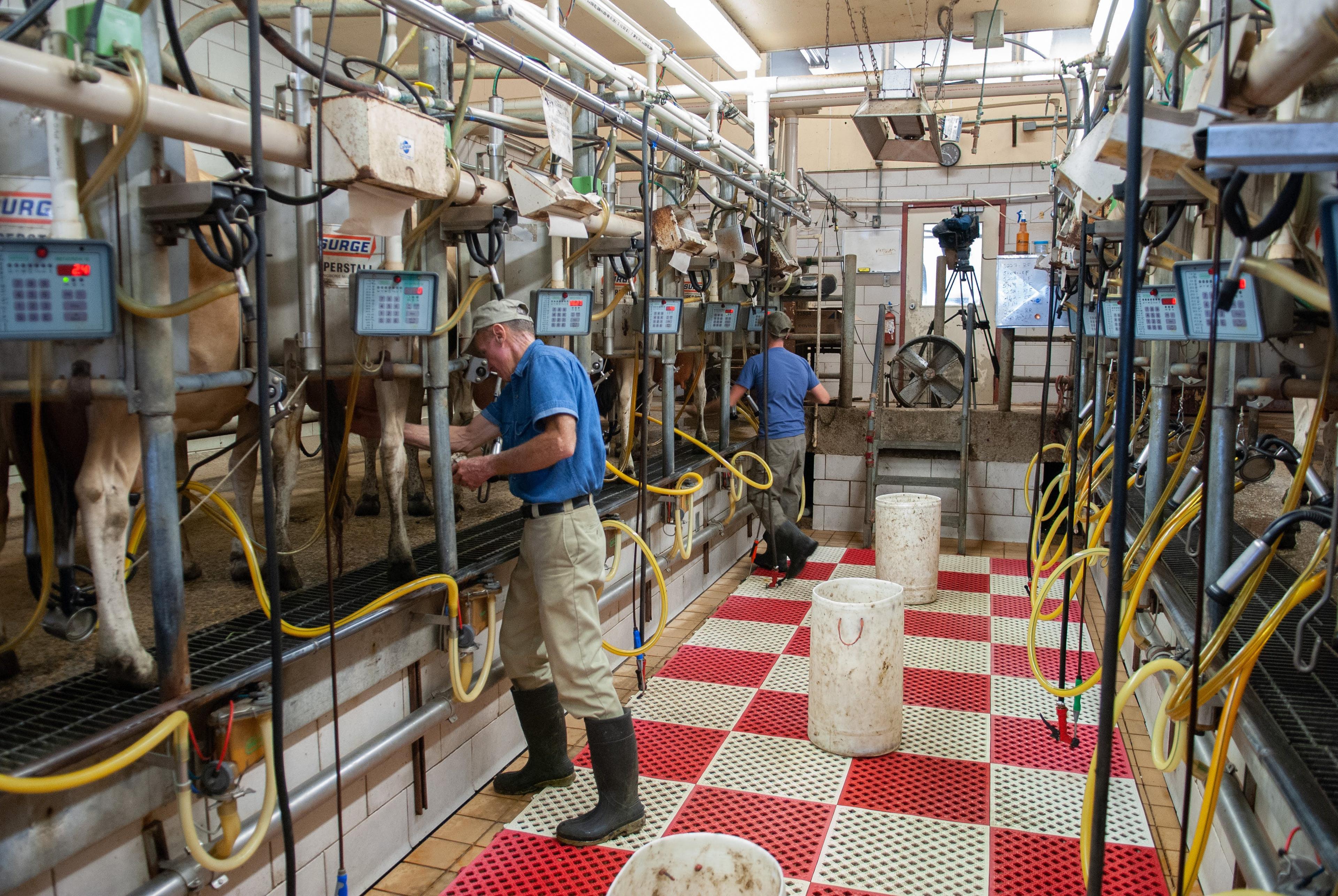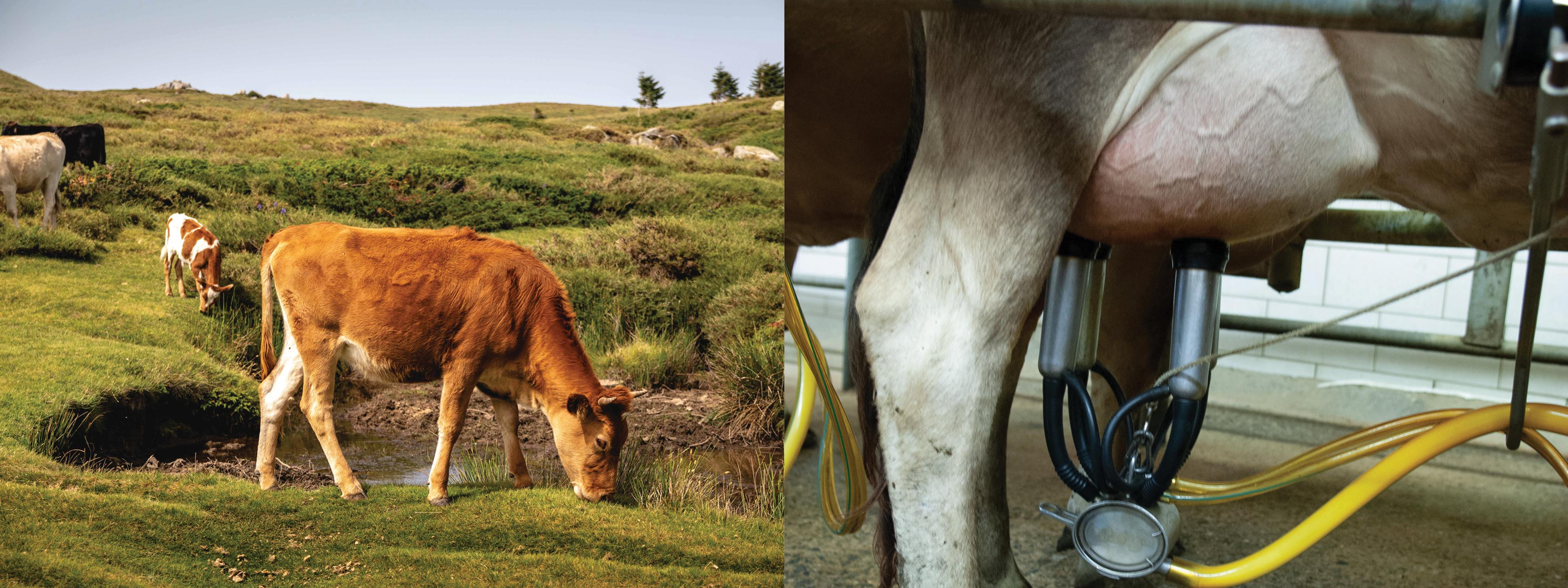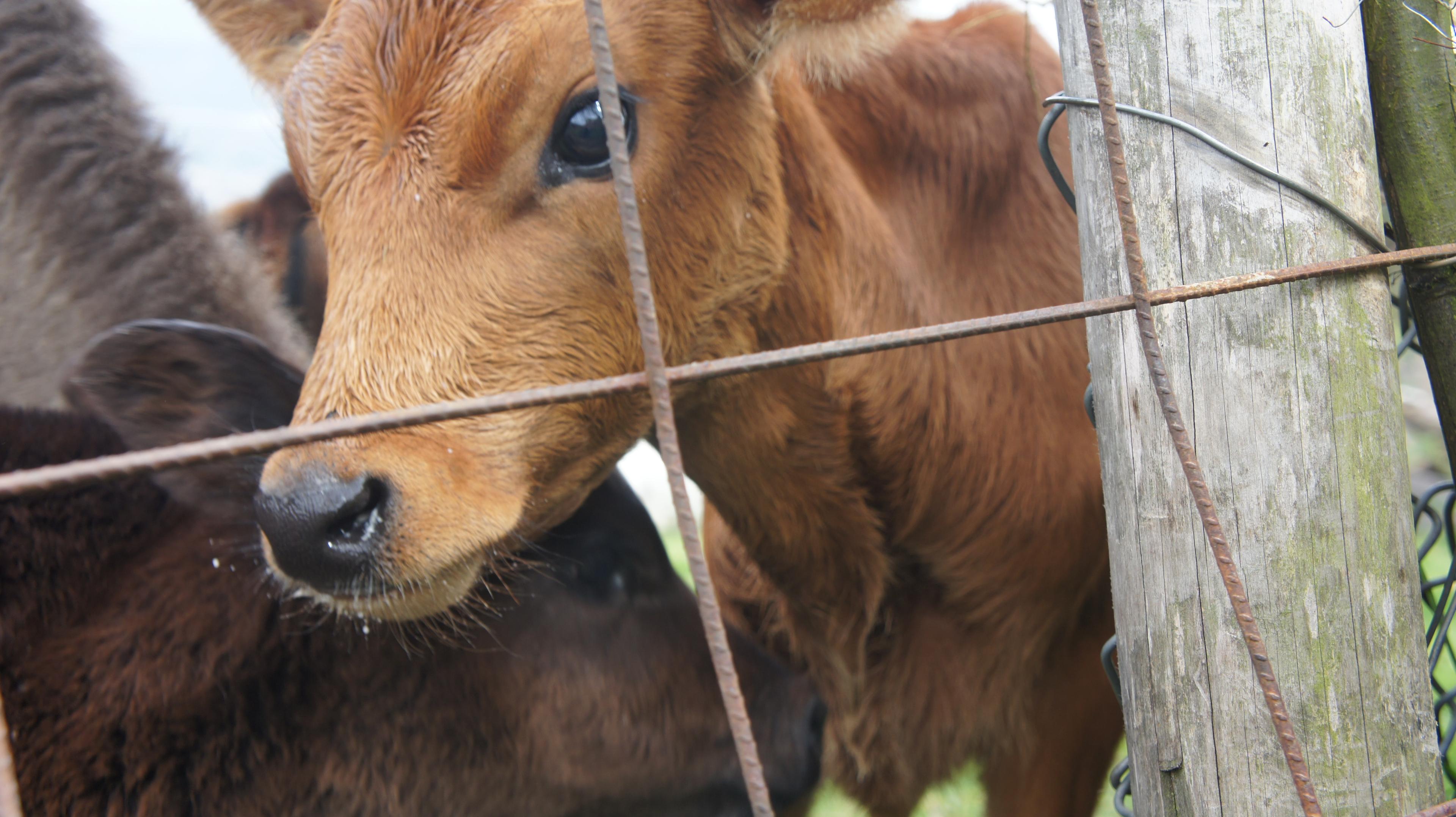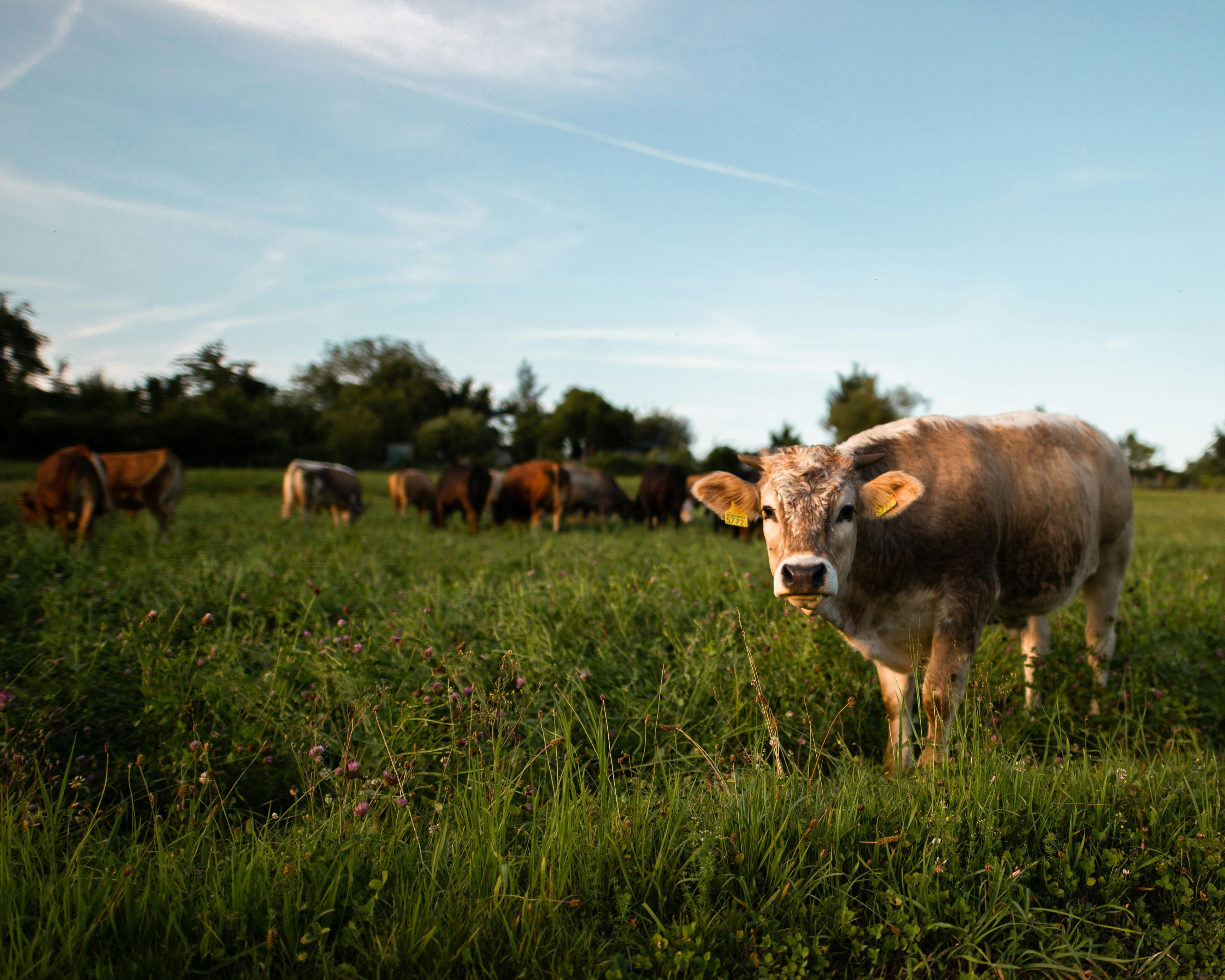Dairy Diaries
Australian dairy farming is in the midst of change. After the deregulation of the industry in 2000, the mantra quickly became “get big or get out”. Since then, the trend has been towards fewer but larger, more intensive operations, which may put more stress on the environment, dairy cows and resources such as water, grain and land.
Introduction
Farmers are responding to pressures for more milk at lower cost and are adopting methods that aim to maximise production per cow and per farm. In fact, the number of dairy farms has almost halved over the past two decades while total milk production has remained relatively stable. There are an increasing number of farms employing methods popular in the US and Europe, namely semi and total feedlots.
At the other end of the spectrum are a growing number of small, ethically and sustainably-minded dairy farms that are taking dairy farming back to traditional methods to benefit our environment, animals, farmers and health.
Which path will Australian dairy continue to follow?
As consumers, we hold the power to help direct where the Australian dairy industry will go by choosing, wherever possible, ethically produced dairy products. At the same time, our governments need to implement policies that will prevent the further exploitation of dairy cows in the face of growing overseas demand.
Aussies are BIG on dairy
There’s no doubt that dairy is a staple in the Australian diet. In 2020, each of us downed 97 lt of milk, 13.6kg of cheese, 4.1kg of butter and 9.4kg of yoghurt. We are amongst the highest dairy-consuming nations in the world.
Yet how much do we know about the dairy we so enthusiastically gulp? How many of us realise that cows need to give birth to a calf in order to produce milk? How does organic dairy farming differ from conventional? What are the ethical implications of consuming dairy? And finally, are dairy cow belches really hurting the environment?
The Dairy Diaries explores these themes and more in the sections below.
A Brief Overview of Australian Dairy
Cows hooked up to machinery to have milk extracted.
Dairy in Australia is big business. We’ve moved a long way from the initial ‘four cows, a bull and a calf’ brought to Australia by the First Fleet. In 2020, Dairy Australia reported the following statistics:
- Across Australia, there are 5,055 dairy farms and 1.41 million dairy cows
- Nearly 70% of dairy farms are in Victoria
- The number of dairy farms has decreased by 77% since 1980
- The dairy industry employs 43,500 people and is Australia’s fourth largest rural industry after beef, wheat and wool
- In 2019-20, Australian dairy farms produced 8.8 billion litres of milk
- Australia exports 29% of its milk production
- Asian markets are considered growth markets as incomes rise, and diets become more westernised
- Greater China has been Australia’s largest export market, accounting for 32% of exports by volume
- Most Australian dairy farms supplement pasture feed with grain
- Organic dairy sales account for approximately 40 million litres, less than 1%, of total dairy produced in Australia
Who owns what in the Australian dairy industry?
When the dairy industry first came to Australia, lack of refrigeration confined it to a local industry where dairy products were made on-farm and the industry was run by farmer cooperatives who owned the farms, product manufacturing (cheese, butter etc) and transport to wholesalers and retailers.
Nowadays, whilst dairy farms are still mostly owned and operated by Australian families, Australia’s milk processing (turning raw milk into carton milk, cheese, butter and beyond) is dominated by multinational companies, which account for 77% of the industry.
The sector also includes public and private companies and farmer-owned cooperatives.
What does an average Australian dairy farm look like?
While most dairy brands and dairy product manufacturing facilities are corporate-owned, the vast majority of the 5,000+ dairy farms in Australia are family owned and operated. They supply raw milk to one of the industry’s milk processors or dairy product manufacturers either directly or through a cooperative.
The average herd size is 279 cows, though there is an emergent trend towards farm operations of over 1,000 cows.
Most farms milk their cows twice a day, using mechanised milking units. Large-scale farms can milk up to 800 cows per hour, with some even operating 24 hours a day with three equally spaced milkings every 24 hours.
There is variation in how dairy farms operate – most are ‘conventional’, some organic and some biodynamic. Further explanation of how these systems differ can be found below.
How are dairy cows fed in Australia?
There are a variety of feeding systems used on dairy farms in Australia. Mostly, and unlike many dairy farms in the US for instance, Australian dairy cows are fed a combination of pasture and grain or supplementary feed and it is the ratio of these that varies.
Overall, about 60-65% of a cow's diet comes from fresh grazed grass averaged out over a year.
100% pasture-fed and varying amounts of grain/concentrate to supplement
Australian dairy cows are predominantly grass-fed (pastured), however most farmers supplement pasture with grain or other supplementary feed (eg, pellets).
Partial mixed ration (semi feedlots)
Another set of feeding systems uses ‘mixed ration’, a feed mix containing all forages, grains, proteins, minerals, vitamins and additives formulated to a specified nutrient concentration. It’s used to increase the cow’s intake of nutrients in order to ‘maximise performance’, that is, to produce more milk.
Total mixed ration (total feedlots – zero grazing)
Approximately 2% of dairy farms in Australia house their cows in sheds 100% of the time. Cows are not allowed to graze on pasture. Feedlot farms give their cows mixed ration 100% of the time. The system is known as ‘total mixed ration’ and is popular in the US and Europe. In Australia, this occurs mainly in Queensland and South Australia, where 9% and 8% of dairy farms are feedlots, respectively.
While total feedlots in Australian dairy farming are still rare, there are now more semi feedlots than ever before, as farmers respond to pressures to increase milk production per cow and per farm and the number of cows per farm increases.
Environmental and ethical pitfalls of dairy feedlots –
Dairy feedlot farms require a larger number of cows (in excess of 700) to be economically efficient. While proponents of dairy feedlots state that they allow for greater efficiency to be achieved, they pose many environmental and ethical issues, as do all intensive farming systems. These include:
- Potential for substantial pollution from cow effluent if sheds are inappropriately designed, managed or located. At the same time, managing environmental sustainability is more difficult because of the greater number of cows in a smaller area.
- Dependence on irrigation, which will become an increasingly alarming issue as drought and climate change continues to impact natural water supplies.
- Dependence on heavy fuelled machinery to cut and collect pasture and other forages, and transport to housing shed.
- Farms are required to purchase and store at least 12-months forage supply in advance, which may require chemical treatment to prevent infestation by pests, such as the case in high-volume grain silos.
- Cows are confined to indoor sheds, have less space per cow and are never allowed to graze on pasture outdoors, restricting their natural behaviour.
- Cows are more prone to ill-health, including mastitis (a painful condition of the udder), because they are concentrated in larger groups in a smaller area.
- Feedlot sheds are generally gravel-based, which means cows spend long hours standing on hard flooring. This promotes lameness, a painful foot problem.
What are the main ethical concerns surrounding dairy farming?
Bobby calves
A caramel calf behind a grid wire fence.
Bobby calves and the ethical issues surrounding them are an inevitable result of a system that promises year-round supply of milk.
In order to produce milk, cows must give birth to a calf once a year, meaning that cows are impregnated annually. Bobby calves are defined as calves from dairy cows that are less than 30 days old and not with their mothers. Bobby calves are considered surplus because they are not required for the milking herd. Most farms separate the bobby calves from their mothers within twelve hours of birth and send their bobby calves for sale or slaughter within a week of birth. This applies to all male calves and around three quarters of female calves. In 2021, just under 300,000 calves were slaughtered at five days of age. The highest number in the last decade had been about 450,000. Bobby calves can be sold and reared for veal, processed for hides for leather and/or for by-products for the pharmaceutical industry. Female bobby calves can also be reared and exported to dairy farms overseas.
It is industry standard that bobby calves must be provided with mother’s milk and with draught-free shelter whilst they are on the farm. It is also industry standard that bobby calves are adequately fed within 6 hours of transport (for sale or to abattoir). However, calves can spend up to 12 hours in transport and the industry standard for the maximum period of time between a bobby calf’s last feed and its slaughter is currently 30 hours. The extended periods of time that calves may be in transit and without food or water can cause considerable stress to the young animals.
The bobby calf issue applies to both conventional and organic systems, although some farms – particularly smaller organic and biodynamic farms – choose to rear bobby calves on the farm until they are a few months or even a few years old. This is not a common trend since it is currently uneconomical for most farms to maintain bobby calves on farm.
Mastitis
Mastitis – inflammation of the cow’s udder – is a serious animal welfare issue as it causes severe pain and discomfort and in more severe cases even death. It’s caused by bacteria or by injury and affects around 10-15% of dairy cows in the Australian dairy herd. Cows with poor nutrition or on farms with poor hygiene practices are more likely to develop mastitis. Mastitis can be difficult to detect at the early stages and so is more likely to progress to more serious stages on farms with a less ‘hands-on’ approach, such as larger-scale farms.
Lameness
Lameness is a painful condition that impacts a cow’s feet and causes a cow to eat less and lie down more. It is mainly caused by cows having to walk long distances, from having to stand for long periods of time on concrete floors (in milking sheds or feedlots), and wet conditions causing long exposure to moisture that softens hooves. The soles of the feet become worn out and bruised, causing suffering and distress. Some farms address this issue by laying rubber matting on some areas of their concrete flooring.
Disbudding
Many dairy farmers remove the horn bud of calves in order to reduce the risk of injury to other cows and farm workers later on. The procedure is performed by applying heat. Farmers aren’t required to use anaesthetic to perform the procedure, which causes pain, stress and discomfort to the young calves.
What are the environmental impacts of dairy farming in Australia?
Dairy farming affects the environment in a number of significant ways. However, at the end of the day the most important factor determining the overall environmental impact of dairy is the amount of milk produced – the more milk produced, the bigger the impact and the more emissions produced. This is a particular problem as dairy farming in Australia continues to intensify.
It’s worth noting that using organic/biodynamic farming methods reduces overall emissions and environmental impact.
Greenhouse gas emissions
It may come as a surprise that 16% of Australia’s greenhouse emissions are attributed to agriculture and dairy farming is responsible for almost 1/5 of this and about 3% of total national emissions.
In fact, in reality these figures are likely to be higher because of the way emissions are allocated to different sectors in Australia. Indirect emissions from agriculture are currently allocated to other sectors such as transport, processing and ‘stationary energy’ (petroleum refining, electricity generation etc). So emissions from off-farm activities such as fertiliser manufacture, grain production, transport and dairy product manufacturing (bottled milk, cheese, ice cream etc), for instance, are not included. These indirect emissions probably add another 10% to the agricultural total.
Water use
Dairy farms use large amounts of water to irrigate their pasture, to clean out dairy and milking sheds and to provide drinking water to the cows. According to the Australian Bureau of Statistics, the dairy industry accounted for 5% of all agricultural water use in Australia in 2017-18.
The dairy industry has made significant strides in improving water efficiency in recent years. For example, many dairy farmers have installed more efficient irrigation systems and have implemented water-saving measures such as recycling wastewater and reducing water usage during milk processing.
Despite these efforts, the dairy industry still faces significant challenges when it comes to water use. One major challenge is the impact of drought and other weather-related events, which can limit the availability of water for irrigation and other purposes. In addition, some regions of Australia have experienced conflicts between dairy farmers and other water users, such as urban areas or other agricultural industries.
As water scarcity due to climate change becomes more severe, however, and the water resources we do have are needed to supply a growing population, farmers will need to dramatically reduce water consumption and improve water recycling if dairy farming is to be sustainable. There’s a strong link between water use and number of cows, with smaller dairies using less water.
In a study published by CSIRO, they measured the amount of water used to produce a food and whether water was scarce or abundant in the location it was drawn from. After discretionary food and beverage and fruit, dairy was the third highest food group contributing to water scarcity.
Soil and water health
Manure and nutrient run-off from synthetic fertilisers can affect soil health and pollute waterways if not managed properly. In fact, this is one of a dairy farm’s biggest challenges. Synthetic pesticide and herbicide use destroys microbial life important for healthy soil. Soil can also be compacted from overgrazing, which reduces the soil’s ability to grow pasture.
Synthetic fertilisers, Australian dairy farms and the environment
All dairy farms use fertilisers in order to boost pasture growth. In fact, the industry accounts for 25-30% of fertiliser use in Australia. However, conventional farms use synthetic fertilisers derived from fossil fuels, while organic and biodynamic farms use only organic fertilisers in the form of animal manure, compost and other natural preparations.
Synthetic fertilisers, pesticides and herbicides damage soil health in the long term by reducing the soil’s capacity to regenerate. Over time, the soil becomes compacted and loses the microbial life and organic matter necessary to support plant growth.
Synthetic fertilisers are a source of greenhouse gas emissions. The fertiliser industry’s greenhouse emissions are approximately 300 million tonnes CO2 equivalents (the unit of measure used to measure emissions) per year. This is from energy use but also from direct nitrous oxide emissions. Nitrous oxide is a greenhouse gas 310 times more potent than carbon dioxide and is the second biggest source of emissions on dairy farms.
What’s the difference between conventional and organic or biodynamic dairy farming?
Research shows that farming dairy cows using organic methods reduces overall greenhouse gas emissions and nutrient loss when compared to conventional methods. Organic and biodynamic farming practices also improve soil quality and protection of local waterways from nutrient and chemical run-off.
Organic/biodynamic farming relies on fewer inputs such as grain and chemical additives because it treats the farm as a ‘closed loop’ – all nutrients (from things such as dung and urine for instance) are recycled back into the system instead of being allowed to leach into the surrounding environment where they can cause soil and water issues.
Organic/biodynamic dairy farming, where cows are fed mostly pasture, also produces milk of higher nutritional quality as a result of better quality pasture.
Organic dairy farms
Certified organic dairy farms adhere to strict regulations which define how animal health and welfare and environmental sustainability are managed. The use of synthetic chemicals, fertilisers and GMOs are not allowed, instead they use natural composts, manures and other preparations to improve the soil’s capacity to grow pasture (which in turn feeds the cows).
Organic standards also prohibit cows being confined to a feedlot – they must have continuous access to pasture. Cows on certified organic dairy farms can only be fed certified organic feed. Organic dairy farming in Australia only accounts for less than 1% of total dairy production.
Biodynamic dairy farms
Biodynamic farming is a specific type of organic farming that holistically views the farm (soil, plants and animals) as a self-sustaining system. Like in organics, biodynamic farming uses manures and composts but also uses very specific herbal and mineral preparations in order to improve soil and plant structure and health. Any supplementary feed given to cows in this system must be certified biodynamic. Demeter is the biodynamic certification label used in Australia.
Conventional Dairy Farming
- Cows are allowed to be confined to sheds
- Access to pasture is recommended but not compulsory
- Antibiotics can be used
- Growth hormones cannot be used, they are banned in Australia
- Synthetic chemicals can be used
- Supplementary feed does not have to be certified organic/biodynamic
- The use of genetically modified products in fees is allowed but strictly regulated
- Bobby calves can be removed from the mother within 24 hours of birth
- Bobby calves can be transported for sale no less than 5 days after birth
- The maximum period of time between a bobby calf's last feed and its slaughter is 30 hours.
- The cows are on an annual pregnancy schedule
- The average number of years a cow is productive on the farm (which is a good measure of its stress levels) is 2.5-4 years.
Certified Organic/Biodynamic
- Cows are not confined to sheds
- Cows have access to pasture at all times
- Antibiotics, growth hormones and synthetic chemicals are not used
- Supplementary feed has to be certified organic/biodynamic
- The use of genetically modified products in feed is not permitted
- Bobby calves can be removed from the mother within 24 hours of birth
- Bobby calves can be transported for sale no less than 5 days after birth*
- The maximum period of time between a bobby calf's last feed and its slaughter is 30 hours.
- The cows are on an annual pregnancy schedule
- Productive life expectancy is 5 seasons
*Please note, practices of organic/biodynamic farmers vary widely and just because certain practices are allowed, does not mean that every certified farm will use them.
What can I do?
There’s no doubt that consuming dairy at our current rate comes at an environmental and ethical cost. Thankfully there are ways each of us can help encourage players in the dairy industry to continue finding ways to reduce dairy farming’s environmental impact and improve animal welfare:
Choose locally-produced organic/biodynamic dairy products:
If you are able to, buying organic/biodynamic milk, cheese and yoghurt means you’re supporting a better way of dairy farming. Organic/biodynamic dairy farming works to strict standards in order to improve the health of the environment and maximise animal welfare, so you can be assured that the milk you’re consuming is healthy for you, kinder on the cow and better for the planet.
You may need to pay a little extra for this type of dairy because of the extra labour involved – reducing your overall dairy intake can help balance your budget. Organic and Biodynamic certification logos to look out for:
- Australian Organic (ACO)
- AUS-QUAL
- Australian Demeter Biodynamic
- Biodynamic Research Institute (BDRI)NASAA (NCO)
- Organic Food Chaing (OFC)
- Southern Cross Certified (SXC)
Ask questions
If you’re concerned about the ethical implications of dairy farming, ask the farmer about what they do to address them. All dairy farms face the same issues when it comes to bobby calves for instance, so it’s worth asking how the farm addresses these issues so that you can make an informed choice. The sort of questions to consider asking include:
How do you manage the calves on your farm?
Do you buy in grain or other feed to supplement the pasture? If so, what percentage?
Do you use synthetic fertilisers, pesticides or herbicides on the pasture? (of course, certified organic/biodynamic farms are not allowed to use these inputs)
Spread the word
Knowledge is power, so share what you’ve learned with your family, friends and colleagues so that together we can make a real difference.
If you enjoyed reading this article and want to support the work that we are doing, donate today.
